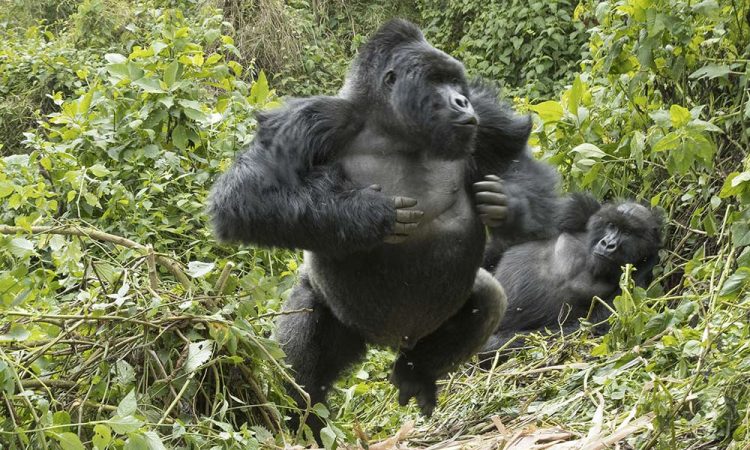What is the climate in Bwindi Impenetrable Forest? Uganda has a tropical, montane rainforest climate…
What should I do when gorillas charge?
 All travelers who come to enjoy gorilla trekking safaris in the different African countries are always inquisitive on their security and safety until they go back home. Travelers always make research about the gorillas before they decide to engage in the gorilla trekking experience, some of these frequently asked questions includes what do I do when gorillas charge?
All travelers who come to enjoy gorilla trekking safaris in the different African countries are always inquisitive on their security and safety until they go back home. Travelers always make research about the gorillas before they decide to engage in the gorilla trekking experience, some of these frequently asked questions includes what do I do when gorillas charge?
Although habituated gorillas are calm, gentle, peaceful and extremely interesting, gorillas are like human beings, they are very sensitive always fight when they get hungry. When gorillas are disturbed and destructed their first reaction they will always do is to charge which is a way of expressing their hunger and ready to fight and protect the family members.
Gorillas found in the natural environment of three African countries such as Uganda, Congo and Rwanda, they live together in groups or family and these are headed and dominated by the mature silverback gorilla who takes up all the responsibilities of a leader in a family, for example the silverback is responsible to decide when the members should eat, where they will feed and it has a key responsibility of protecting the family from all kind of threats and danger from other families. They live in groups of 5 to 30 members that is composed of babies, juveniles, the mature females as well as the adult silverback gorillas heads the family and it is rare that you will two silverback gorillas in one group, since they fight for leadership and when one is defeated then, it is forced to live and find itself a family.
When a silverback gorilla senses danger about the family members, it will stand upright on its behind legs, then it will swell with its should muscles up, then it will start pounding its chest with its hands, at times it will make some loud noise or hoots. And when the silverback gorilla expresses this kind of aggressive reactions, this is what is termed as charging, a sigh that it’s ready to face danger or fight back to any threat.
Why do gorillas charge?
 There are several reasons why a silverback gorilla charges, such as; gorillas can get threatened when just hear too much noise of visitors who come to their natural environment this only sigh of danger to the gorillas, when they see a predator such as the leopard and they want to protect their family members, when they meet with another family group and they want to take away some members.
There are several reasons why a silverback gorilla charges, such as; gorillas can get threatened when just hear too much noise of visitors who come to their natural environment this only sigh of danger to the gorillas, when they see a predator such as the leopard and they want to protect their family members, when they meet with another family group and they want to take away some members.
It is also very possible that during the gorilla trekking experience or habituation process, gorillas can be found when they are not interested in meeting with the human beings or when they have already been threatened by danger thus they will look at the presence of human being as another threat, thus they will charge so as to protect themselves.
What to do when gorillas charge?
Both gorilla trekking experience and gorilla habituation in all national parks where the activity is done will always start with briefing at 7:00 AM before the actual activity begins. In the briefing sections a lot of security and safety measures are told to travelers, some of them is how to protect yourself in case a gorilla charges when you encounter a gorilla family. Precautions of how to protect yourself when gorillas charge include;
Getting down on your knees or lower yourself on the ground and show that you are nothing to the silverback thus it will see no reason of attacking you. As you lower yourself to the ground, the ranger guide will instruct you to be quiet, show some kind of respect to the silverback gorilla, bend down the ground.
Don’t run instead walk gently slowly away from it, traveler are advised not to run due to the fact that when you run the silverback gorilla will run after you and attack you, therefore when a gorilla charges, walk away stepping backwards slowly and it is better not to continue closer to towards it because it will assume you’re your drawing near to it to attack it.
Follow the guide instructions, for any gorilla trekking experience in the jungle, the activity is done with an escort of armed park ranger guides who are usually two, one at the front while another in the front. The park ranger guides are experienced and they different technics of how to treat a gorilla in incase it charges. We therefore advise travelers to always listen to the instructions of the guide incase such an incident happens because the park ranger guides accompanies your trekking in the jungle to ensure that you are safe and also to help you spot a gorilla family.
When a gorilla charges, it is advisable that travelers should avoid making direct contact into the eyes of the gorilla instead to pretend minding their own business. This because gorillas are naturally shy creatures, therefpore when they charge and you directly in their eyes they perceive you as an enemy so they will attack you.
Pretend to like a gorilla or any other ape, this involves opening your mouth and showing your teeth as you also shout back to the gorilla, pounds your chest. By doing this the gorilla will ignore you and it will assume you are also fellow wild gorilla thus it will quit charging.
Keeping the recommended standard distance of about 7 meters from a gorilla family when you go trekking in the jungle. This is due to the fact that gorillas are wild animals they can easily attack you especially when they charge to defend themselves.
In conclusion, habituated gorillas are gentle and peaceful they rarely charge unless they have sensed danger which is part of their nature, that’s how they react in order to fight and protect their families. It is also very important that travelers keep instructions and guidelines that are given to them during the briefing sessions to avoid bad experiences of gorillas charging while on your trekking such as avoid to using flash cameras, not making loud noise while in the forest among other destructive actions. When travelers avoid this there are very higher chances of experiencing a piece gorilla trekking adventure in the jungle without noticing issues of charging.



